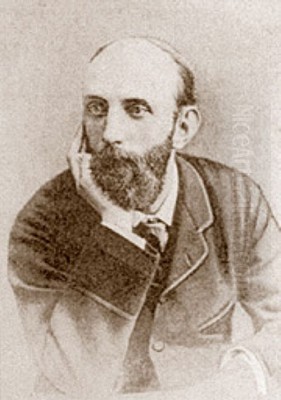
John Melhuish Strudwick, an artist whose life spanned from the zenith of Victorian optimism to the turbulent modern era, remains a fascinating, if somewhat enigmatic, figure in the landscape of British art. Born in Clapham, London, on May 6, 1849, and passing away on July 16, 1937, Strudwick carved a unique niche for himself as one of the last true adherents to the Pre-Raphaelite aesthetic. His work, characterized by meticulous detail, rich jewel-like colours, and a profound engagement with mythological, biblical, and literary themes, offers a window into a sensibility that valued beauty, craftsmanship, and narrative depth above all else.
Early Life and Artistic Awakenings
Strudwick's journey into the art world was not initially marked by prodigious success. He hailed from a comfortable middle-class background, which afforded him the opportunity to pursue an artistic education. He enrolled at the prestigious Royal Academy Schools in London, the traditional training ground for aspiring British artists. However, his time there was reportedly undistinguished. The prevailing academic methods, which often emphasized a more classical and perhaps less imaginative approach, did not seem to resonate deeply with Strudwick's burgeoning artistic inclinations.
During his formative years, he is said to have briefly attempted to emulate the style of the Scottish landscape painter John Peter Aitken. This early exploration suggests a search for an artistic voice, a period of experimentation before he found the path that would define his career. The highly structured environment of the Royal Academy, with its focus on drawing from the antique and life models according to established conventions, may have felt restrictive to an artist who would later become known for his intensely personal and imaginative visions.
It was outside the formal confines of the Academy that Strudwick would find his true artistic direction. The mid-Victorian art scene was a vibrant and diverse one, with various movements and counter-movements vying for attention. While academicians like Frederic Leighton and Lawrence Alma-Tadema were achieving immense popularity with their grand classical and historical scenes, a different sensibility, rooted in the ideals of the Pre-Raphaelite Brotherhood, continued to exert a powerful influence.
The Transformative Influence of Edward Burne-Jones
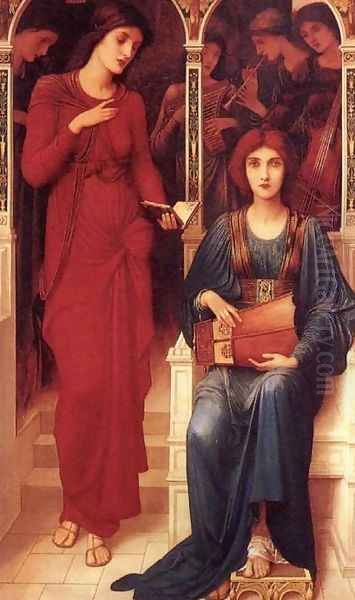
The pivotal moment in John Melhuish Strudwick's artistic development came in the early 1870s when he entered the orbit of Edward Burne-Jones. Burne-Jones, a leading figure of the second wave of Pre-Raphaelitism, often associated with the Aesthetic Movement, had established a busy studio producing paintings, stained glass designs, and tapestries. Strudwick secured a position as a studio assistant, a role that proved to be profoundly formative.
Working alongside Burne-Jones, Strudwick was immersed in an environment dedicated to the pursuit of beauty, inspired by medieval romance, classical mythology, and early Renaissance art. Burne-Jones's own style, with its elongated, melancholic figures, intricate patterns, and dreamlike atmospheres, left an indelible mark on his assistant. Strudwick absorbed not only the technical aspects of painting, such as the careful preparation of canvases and the layering of colours, but also the thematic concerns and aesthetic philosophy that underpinned his master's work. Other artists who passed through Burne-Jones's circle or shared a similar aesthetic included Thomas Matthews Rooke and Charles Fairfax Murray, contributing to a shared artistic milieu.
This period of apprenticeship was crucial. It allowed Strudwick to move beyond his earlier, less certain efforts and to cultivate a distinctive style that, while clearly indebted to Burne-Jones, possessed its own unique qualities. He learned the importance of meticulous craftsmanship, the evocative power of symbolism, and the creation of self-contained, otherworldly pictorial spaces. The influence of John Roddam Spencer Stanhope, another artist closely associated with Burne-Jones and known for his Italianate Pre-Raphaelite works, can also be discerned in Strudwick's developing aesthetic.
The Emergence of a Distinctive Style
By the mid-1870s, Strudwick began to exhibit works that showcased his mature style. His paintings are immediately recognizable for their extraordinary attention to detail. Every element, from the folds of drapery and the rendering of musical instruments to the depiction of flowers and architectural ornamentation, is executed with painstaking precision. This meticulousness gives his works an almost jewel-like quality, inviting close inspection and rewarding the viewer with a wealth of finely observed particulars.
His colour palettes are typically rich and deep, often employing sumptuous crimsons, blues, and golds, reminiscent of illuminated manuscripts or early Renaissance panel paintings. Unlike the brighter, more naturalistic light favoured by the original Pre-Raphaelite Brotherhood members like John Everett Millais or William Holman Hunt in their earlier phases, Strudwick's lighting is often more subdued and atmospheric, contributing to the dreamlike quality of his scenes.
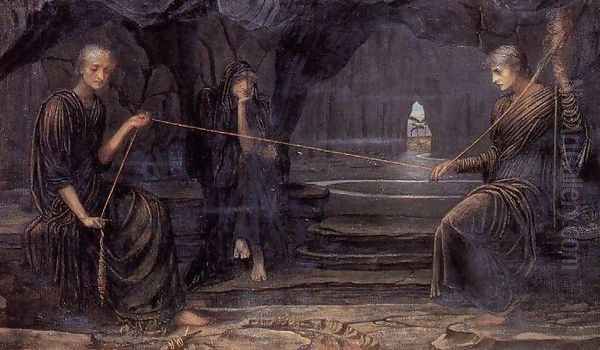
A notable characteristic of Strudwick's compositions is a tendency towards a shallow pictorial space, often resembling a frieze or a tapestry. Figures are frequently arranged in a relatively flat plane, with limited perspective depth. This stylistic choice, combined with the intricate surface detail, enhances the decorative quality of his work and aligns it with the principles of the Aesthetic Movement, which emphasized "art for art's sake" and the intrinsic beauty of form and colour. His figures, often slender and ethereal, possess a quiet grace and an introspective quality, conveying a sense of melancholy or contemplation.
Thematic Concerns: Music, Myth, and Mortality
Strudwick's subject matter was drawn primarily from the realms of allegory, mythology, literature, and music. Music, in particular, is a recurring motif in his oeuvre, often symbolizing harmony, spiritual transcendence, or the ephemeral nature of beauty. Titles such as A Symphony (exhibited 1870s, though some sources date it earlier, reflecting his emerging style under Burne-Jones) and Canzone senza parole (Song Without Words), first exhibited in 1875, explicitly reference musical forms. The latter, a particularly poignant work, depicts figures who could be interpreted as the Fates, weaving the thread of life, set against a backdrop of autumnal decay, evoking a sense of gentle sorrow and the passage of time.
Classical myths and medieval legends provided another rich vein of inspiration. Unlike some of his contemporaries who might have focused on the more dramatic or heroic aspects of these stories, Strudwick often chose moments of quiet contemplation or symbolic significance. His figures are less actors in a grand narrative and more embodiments of abstract concepts like love, beauty, or fate. This approach aligns him with Symbolist tendencies, where the visual elements are intended to evoke ideas and emotions rather than simply illustrate a story.
His painting A Golden Thread (1885) is a prime example, featuring allegorical female figures, likely representing the Moirai or Fates, spinning a golden thread, a powerful symbol of destiny and the interconnectedness of life. The meticulous rendering of their garments and the surrounding flora contributes to the painting's rich, decorative surface. Similarly, Love's Palace (1893) uses an allegorical framework to explore the complexities of love, with figures arranged in a carefully structured, almost architectural composition.
Notable Works and Their Characteristics
Several of Strudwick's paintings stand out as quintessential examples of his art. In the Golden Days, completed later in his career around 1907, encapsulates his nostalgic yearning for an idealized past. It depicts a serene, courtly scene with figures in medieval-inspired attire, engaged in leisurely pursuits, surrounded by lush vegetation and intricate architectural details. The painting evokes a sense of timeless beauty and harmony, a common theme in late Pre-Raphaelite art.
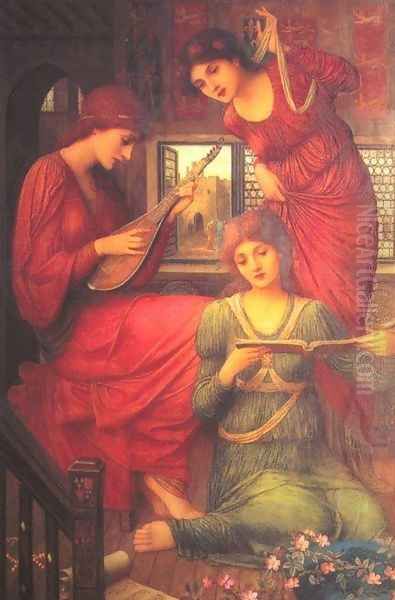
An Angel (1895) showcases his ability to imbue religious or spiritual subjects with a delicate, otherworldly quality. The angel, with intricately rendered wings and flowing robes, often holding a musical instrument, is a recurring figure in his work, symbolizing divine harmony or a messenger from a higher realm. The Angel with the Lute is another such example, emphasizing the celestial connection to music.
His work Isabella (1879), likely inspired by John Keats's poem "Isabella, or the Pot of Basil," a popular subject among Pre-Raphaelite artists including Millais, would have allowed Strudwick to explore themes of love, loss, and devotion, rendered with his characteristic attention to emotional nuance and detailed setting. The Ten Virgins (1884), a biblical parable, offered scope for a multi-figure composition exploring themes of preparedness and divine judgment, likely treated with his typical sensitivity and decorative richness.
One of his most evocative titles, and a work that captures the melancholic beauty of his art, is Thy Music, faintly falling, dies away / And the bleak Provincial Air / Is hanging in the void / And I am again alone. The very length and poetic nature of the title suggest the painting's introspective and perhaps sorrowful mood, a hallmark of much of his output. Other significant works include The Gentle Music of a Bygone Day, Passing Days, and depictions of St. Cecilia, the patron saint of music, further underscoring his fascination with musical themes.
Exhibitions, Patronage, and Critical Reception
Strudwick primarily exhibited his works at the Grosvenor Gallery and, later, at its successor, the New Gallery. These venues were established as alternatives to the Royal Academy and became important showcases for artists associated with the Aesthetic Movement and the later phase of Pre-Raphaelitism, including Burne-Jones, George Frederic Watts, and Walter Crane. Exhibiting alongside such luminaries provided Strudwick with a sympathetic platform for his highly individual style.
His meticulous, labour-intensive technique meant that he was not a prolific artist. Each painting was a product of considerable time and effort. He found support among a select group of patrons who appreciated the unique qualities of his work. Notable collectors included the Liverpool shipowners William Imrie and George Holt, who were significant patrons of late Pre-Raphaelite art. Their support was crucial for an artist like Strudwick, whose painstaking methods and relatively small output might not have appealed to a broader market.
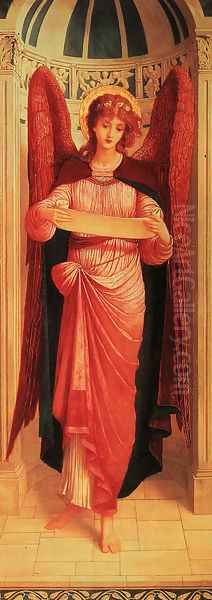
Critical reception of Strudwick's work was mixed, reflecting the changing artistic tastes of the late Victorian and Edwardian periods. While some critics admired his technical skill and the poetic intensity of his visions, others found his style anachronistic or overly sentimental. The art critic George Bernard Shaw, known for his sharp wit, famously, though perhaps somewhat unfairly, characterized Strudwick's work as being overly focused on the minutiae of drapery and accessories, suggesting that his figures were secondary to their elaborate costumes. This criticism, while highlighting his dedication to detail, perhaps overlooked the emotional depth and symbolic richness of his paintings. It was also noted by some that his extreme focus on detail sometimes led to a loss of broader compositional strength or even the loss of important patrons who grew impatient with his slow production.
Comparisons with Contemporaries
Strudwick's art is best understood in the context of his contemporaries. His debt to Edward Burne-Jones is undeniable, sharing a similar repertoire of elongated figures, medieval and classical themes, and a dreamlike atmosphere. However, Strudwick's work is often smaller in scale and even more intensely detailed, with a harder, more enamel-like surface finish than Burne-Jones's often softer, more painterly later style.
Compared to Dante Gabriel Rossetti, one of the founders of the Pre-Raphaelite Brotherhood, Strudwick's female figures are generally less overtly sensuous and more ethereal. Rossetti's later work often focused on powerful, brooding female archetypes, while Strudwick's women tend to be more delicate and introspective. Both artists, however, shared a love for literary and symbolic themes.
William Morris, another key figure in the Arts and Crafts Movement and a close associate of Burne-Jones, shared Strudwick's interest in medievalism and craftsmanship. While Morris expressed these ideals primarily through decorative arts, textiles, and literature, Strudwick translated them into his easel paintings. The emphasis on intricate pattern and rich materials found in Morris's designs resonates with the decorative qualities of Strudwick's art.
Other artists of the period offer further points of comparison. The classical subjects and meticulous detail seen in the works of Frederic Leighton or Lawrence Alma-Tadema represent a different, more academic strand of Victorian art, but share a commitment to high finish and historical verisimilitude, albeit with a different aesthetic goal. The symbolist works of G.F. Watts, with their grand allegorical themes, offer a parallel in terms of serious artistic intent, though Watts often worked on a much larger scale and with a broader, more monumental style. Figures like Simeon Solomon and Evelyn De Morgan also explored similar mythological and allegorical territories, each with their distinct personal inflections within the broader Aesthetic and late Pre-Raphaelite currents. Marie Spartali Stillman, another prominent female Pre-Raphaelite, also created works of intense beauty and literary depth.
Later Life, Challenges, and Seclusion
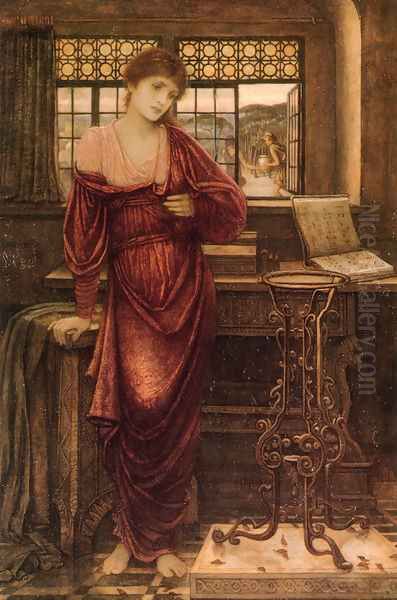
As the 19th century gave way to the 20th, artistic tastes began to shift dramatically. The rise of Impressionism, Post-Impressionism, and various Modernist movements led to a decline in the popularity of Pre-Raphaelite and Aesthetic art. Strudwick, steadfast in his artistic vision, found himself increasingly out of step with contemporary trends.
His later life was marked by a growing reclusiveness. He reportedly lived a quiet, almost hermit-like existence, dedicated to his painstaking art. There are accounts suggesting that he faced personal challenges, including struggles with alcohol, which may have further contributed to his withdrawal from the public eye and impacted his productivity. One particularly difficult period around 1884 is sometimes mentioned, with some sources suggesting he faced legal troubles and was even briefly committed to a workhouse, an experience that would undoubtedly have been deeply distressing and could have intensified his desire for privacy.
Despite the waning public interest in his style, Strudwick continued to paint, driven by his own exacting standards and personal vision. He largely rejected the pursuit of public acclaim, preferring the quiet solitude of his studio. This dedication to his craft, even in the face of changing fashions, speaks to the depth of his artistic convictions.
Legacy and Enduring Appeal
For many years after his death in 1937, John Melhuish Strudwick, like many Victorian artists, languished in relative obscurity. However, the latter half of the 20th century saw a renewed interest in Pre-Raphaelite and Victorian art, leading to a reappraisal of his work. Today, he is recognized as a significant, if highly individual, exponent of the late Pre-Raphaelite tradition.
His paintings are admired for their exquisite craftsmanship, their jewel-like beauty, and their evocative power. While his output was not large, each work is a testament to his unwavering dedication to his artistic ideals. His art offers a quiet escape into a world of myth, music, and melancholic beauty, a world meticulously constructed with an almost devotional intensity.
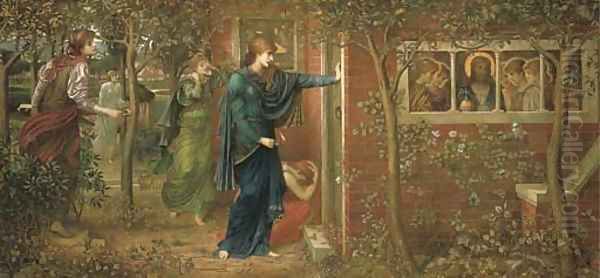
Strudwick's legacy lies in his unique ability to synthesize the influences of his predecessors, particularly Burne-Jones, into a highly personal style. He represents the final flowering of a particular artistic sensibility, one that valued intricate detail, symbolic depth, and the pursuit of an idealized beauty. In an art world increasingly dominated by rapid change and bold experimentation, Strudwick's quiet, contemplative art stands as a poignant reminder of a different era and a different set of artistic priorities. His works continue to fascinate viewers who appreciate the subtle magic and meticulous artistry of one of Pre-Raphaelitism's most devoted, if secluded, practitioners. His paintings can be found in several public collections, ensuring that his unique vision endures.